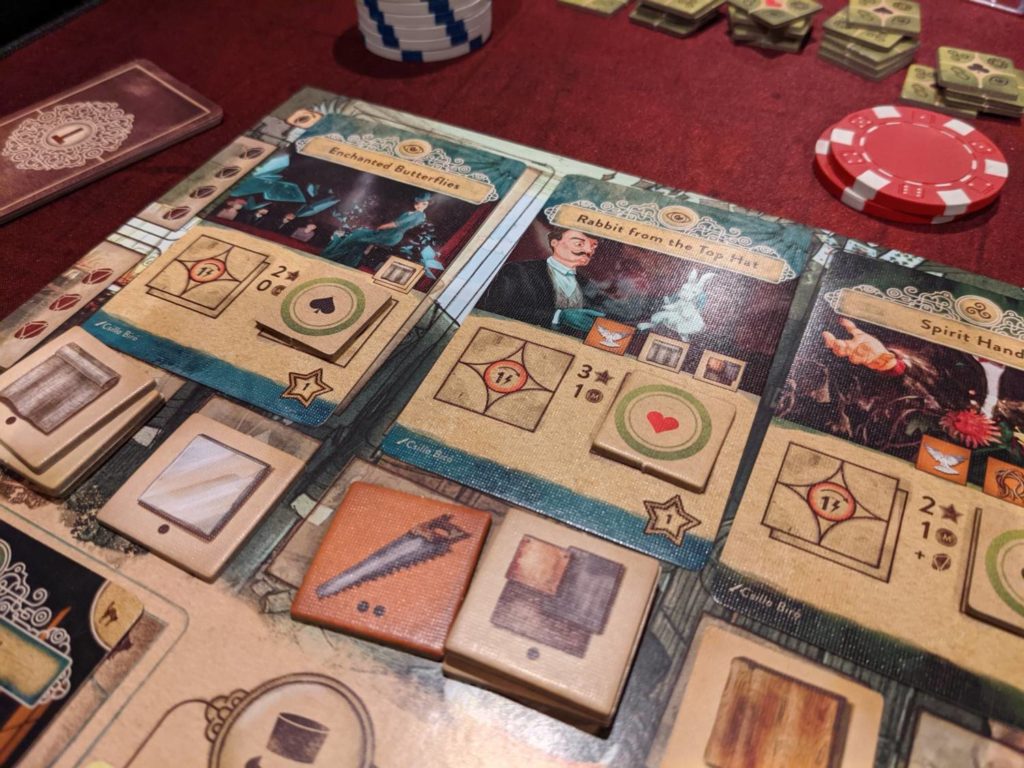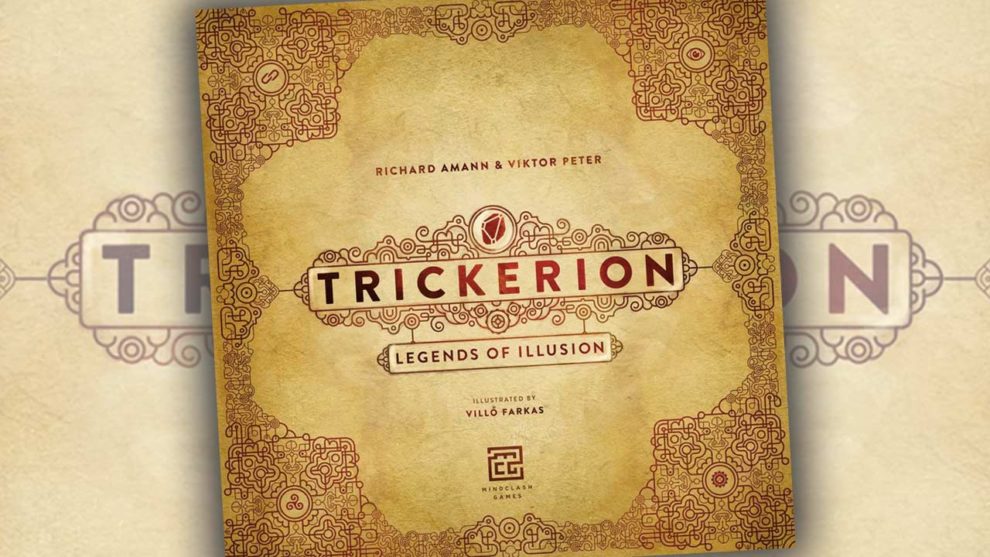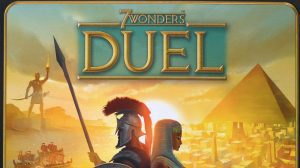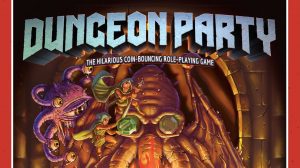8As a part of an upcoming Publisher Profile on Mindclash Games, I wanted to go back to where it all began.
Trickerion: Legends of Illusion is a 2015 release set in a world that feels a lot like video games such as Bioshock and We Happy Few, a Victorian steampunk setting that looks both dated and futuristic. I love worlds like this, so Trickerion scratches a certain itch for me every time I sit at the table to soak in the visuals.
Trickerion is a success in almost every way. The game, designed by Richard Amann and Mindclash CEO Viktor Peter, was nominated for a number of tabletop awards, including a BGG Golden Geek award when it was first released. It has also spawned a few expansions and a collector’s edition in 2019. A few people in my gaming circles swear that Trickerion is their favorite strategy board game; those superfans were the reason I had copies of the game to play for this review.
Explaining the rules of Trickerion in a short written article is essentially impossible; the game’s rulebook is 28 pages long, and that’s before you get to the player aid known as the Magician Workbook, which lists all of the game’s illusions, steps for each round, and some examples of play.
I thought it would be more interesting to describe my experiences playing Trickerion, a game I’ve played maybe five times over the last six years. After a recent play, I realized that we hadn’t posted a full article on Trickerion so here’s my take on the game.

No One Does the Pre-Work
Outside of my work here at Meeple Mountain, I’m the director of diversity, equity & inclusion at a consumer products firm and an executive communications coach on the side. I build and facilitate a variety of training courses; while there are plenty of mantras master facilitators live by, one is really appropriate when considering games like Trickerion:
“No one does the pre-work.”
Here’s what I mean. If I assign a training group three papers to read and a worksheet to complete prior to the start of a class a week from now, without fail 75% of the people in the class won’t do it. No shot. I’ve heard every excuse under the sun, but the point is always the same: most people expect to plop their bottom into a comfy office chair and be dazzled for the eight-hour day we’ve all agreed on. You want me to do even 20 minutes of work to prepare? Bah, humbug!
Each time I play Trickerion, I always say the same thing: this game might have the most pre-work in tabletop history. That’s because the setup is tough; giving players all of the various player boards, permanent assignment cards, wooden pieces, dice, shards, specialist player boards, and magician cards is a lot.
And Trickerion is a hog for all hog time when it comes to table space. With no expansions, Trickerion will eat your entire table. Pulling in a side table is not surprising. Fancy game tables with room for drinks in coasters off the side still might not save you. (I should know—I have a fancy game table with room for drinks that sit off the table.)
So, just preparing for a night of Trickerion is a quest. But then the real pre-work begins. I would argue that a game of Trickerion is actually two games.
The first game: selecting a magician as your player character and the leader of your contingent of engineers, assistants, managers and apprentices. There are a fine array of choices just for your magician; if you are not playing with The Dark Alley expansion, this is quicker, but then again, no one I know seems to ever want to play the game without The Dark Alley. (For the record: Trickerion is great without the expansion. I’ll happily play the game in its vanilla ice cream format, stripped of any of the extras.)
Then, everyone has to select a specialist, which is a pretty crucial choice—how will that play into the starting illusion that each player has picked up? All players also have to grab materials (“Components”) worth a total value of two coins—which will those be? And based on player order, how much money will each person have when play begins?
I’ve seen this first game (which isn’t even the real game!!) take anywhere from 20-60 minutes. Seriously. It’s worse when adding one of the many expansions to the game; with Dahlgaard’s Academy, players also have to draft ongoing magician powers from a pool of 12 cards. Oh my goodness, this process adds so much time as well.
You might find that the Trickerion pre-game process is as heavy, if not heavier (which is really saying something) than the actual game. And while the rulebook provides a snapshot of what beginners should do for their first game, most gamers I know are snobs—they look at advice like I view country clubs—with complete and utter disdain.
I find that I never want to do the pre-work with Trickerion. But whenever I clear that mental hurdle…my, oh my.

But Then…That Game!
When the actual Trickerion experience begins, that ol’ Mindclash magic begins to take shape.
The world building is nothing short of excellent. Seriously—like the content developed for Anachrony (also a Mindclash release), Trickerion feels like a living, breathing place, full of (fictional) history and reasons for each character to be in existence. The board is busy but such a beauty. Working outward from the theater area where magicians have to perform each week, the areas for the Market Row, Dark Alley, and Downtown make it easy from a distance to determine what needs doing from round to round.
I paid special attention to the Advertisement cards during a recent play; yes, they are beautiful, but these cards again lean into the world that was created for this game. The artwork by Villő Farkas and László Fejes is spectacular, and I love how “olden-time” those magician posters look. Touches like these are what make Mindclash’s attention to detail so special.
The look and feel of a round of Trickerion all makes sense to me. At its heart, Trickerion is a worker placement game, with players running around the city of Magoria using their magician, apprentice and additional team members to buy materials needed to put on a show at the end of the week. The intersection of worker placement and the action points system—certain workers have more starting action points than others, and each worker placement spot gives a certain number of bonus action points—creates tension on almost every turn.
Watching players stare at the revealed plans of other players is also a treat. During the big reveal after player order and plan assignments have been completed, each player flips their cards to show where each of their workers plan to go in the round. Then on each turn, everyone has the chance to move just one of their workers to the place they want. Inevitably, the groaning begins right away.
“I KNEW you were gonna take the Thursday performance slot, you rat!”
“Of course you took the only spot where I could actually use someone to grab a new illusion on this turn.”
“Come on man! Don’t put your prepped trick on that space! I need that SHARD!!!!”
Going first in a game of Trickerion is fun, but watching the table react to a great move during this phase or taking the components they need to take an illusion that you are also trying to grab? Oh my goodness. The tradeoffs with these choices worked even during my first play of this game, and nothing has changed with successive plays.
Performances at the end of the week? Another example of a game within a game, thanks to the minigame puzzle of figuring out where to place prepared tricks to score points with linked illusions and specialists working backstage.
The Performance Phase is a blast; much of the game’s scoring happens here, some of the magicians have powers that can affect how various theaters are executed, and the “strategerie” behind deciding whether to go first on a Thursday—meaning each illusion performed that weekend will be worth one less point and one less coin per trick—and last on a Sunday is huge. Sunday’s bonuses are almost always worth it, but there’s a chance that the Sunday performer is left holding the bag, not able to perform the tricks on a theater card at all that round…but every trick of the Sunday performer that is performed grants that magician extra points and cash.

Thirty Minutes Per Player? Nope!
Trickerion is fantastic, but it comes with a lot of strings attached.
The box implies that playtime comes out to about 30 minutes per player. In my experience, games of Trickerion have lasted 60-90 minutes per player. The most recent game I played prior to writing this review took about four hours…and we only got through five of the seven rounds.
This is a big piece of chicken, my friends. The weight is large, the playtime is massive, and I would use similar words to describe the amount of table real estate this takes up. Trickerion is one of the worst single-play games in history—the rules overhead is outrageous, and that’s just to play the game; to prepare to play the game and do the steps required to get through pre-work, Trickerion requires real focus and a hell of a lot of bourbon. (Bourbon usage may vary.)
But once you get rolling, Trickerion is such a joy to play. The mix of decisions and consequences is really something else; I have seen players freeze up staring at the table, wondering what a neighboring player will do while knowing that everything that was planned on this turn is crucial to scoring points during the Performance Phase.
It’s a stellar production, like other Mindclash experiences such as Astra and the upcoming Voidfall. When you look back at the experience, you’ll be able to capture those moments when you really nailed a strong turn, or when you blew it and opened the door to competition.
A note about The Dark Alley expansion, and every other piece of Trickerion expansion content I’ve seen so far: the term “broken” or “overpowered” are used so much in the context of card abilities that my sense is everything is broken, which means everything is normal.
Some of the swingy things I’ve seen on the “Special Assignment” cards (one-time power cards that replace the location cards used in the base game when a player wants to supercharge a single turn) are comical. It almost feels like some of the cards say “If your name is Justin and it’s a Tuesday IRL, score 10 points during the next Performance Phase then skip wages for all of your staff for this round.”
Like, OUT OF CONTROL broken. But, anyone can buy those cards. The magician abilities from the expansion Dahlgaard’s Academy are so ridiculous that by the time a player snaked me with a power that allowed him to go first in every round regardless of the actual player order, I just threw my hands up.
I agree that it’s more fun if everyone has access to superpowers, I really do. I just don’t think a game like Trickerion really needs it.
All of this means you can’t go wrong. Whether it is the base game or the addition of any of the expansions, Trickerion holds up and continues to justify its place in the hearts of heavy strategy gamers. I continue to be excited by the future of Mindclash!












Add Comment